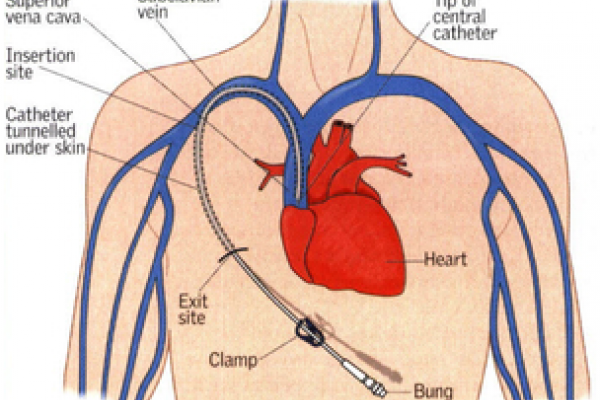In patients requiring long-term intravenous (IV) drug therapy, total parenteral nutrition, temporary access for kidney dialysis, or frequent blood testing, repeated access to a vein may be necessary over an extended period of time. Multiple needle sticks into a vein can be difficult, painful, and time-consuming. In such cases, a thin, flexible tube system known as a central venous catheter (also called a central line) may be inserted under the skin and into a large vein. This type of catheter may be safely and comfortably left in place for days, weeks, or months. The various types of central venous catheters require specific types of care. – See more at: https://www.uspharmacist.com/article/central-venous-catheters-and-iv-ports#sthash.Gs7M4aCs.dpuf
In patients requiring long-term intravenous (IV) drug therapy, total parenteral nutrition, temporary access for kidney dialysis, or frequent blood testing, repeated access to a vein may be necessary over an extended period of time. Multiple needle sticks into a vein can be difficult, painful, and time-consuming. In such cases, a thin, flexible tube system known as a central venous catheter (also called a central line) may be inserted under the skin and into a large vein. This type of catheter may be safely and comfortably left in place for days, weeks, or months. The various types of central venous catheters require specific types of care. – See more at: https://www.uspharmacist.com/article/central-venous-catheters-and-iv-ports#sthash.Gs7M4aCs.dpuf
In patients requiring long-term intravenous (IV) drug therapy, total parenteral nutrition, temporary access for kidney dialysis, or frequent blood testing, repeated access to a vein may be necessary over an extended period of time. Multiple needle sticks into a vein can be difficult, painful, and time-consuming. In such cases, a thin, flexible tube system known as a central venous catheter (also called a central line) may be inserted under the skin and into a large vein. This type of catheter may be safely and comfortably left in place for days, weeks, or months. The various types of central venous catheters require specific types of care. – See more at: https://www.uspharmacist.com/article/central-venous-catheters-and-iv-ports#sthash.Gs7M4aCs.dpuf
In patients requiring long-term intravenous (IV) drug therapy, total parenteral nutrition, temporary access for kidney dialysis, or frequent blood testing, repeated access to a vein may be necessary over an extended period of time. Multiple needle sticks into a vein can be difficult, painful, and time-consuming. In such cases, a thin, flexible tube system known as a central venous catheter (also called a central line) may be inserted under the skin and into a large vein. This type of catheter may be safely and comfortably left in place for days, weeks, or months. The various types of central venous catheters require specific types of care.
Central Venous Catheters Must Be Periodically Flushed With Sterile Solution To Prevent Blockage
Central venous catheters are useful devices, especially in patients receiving IV antibiotics, cancer chemotherapy treatments, or chronic pain medications. Some chemotherapy drugs can damage the tissue around the vein if the needle is not positioned correctly, especially in the small veins of the hand and lower arm. A central venous catheter has a larger diameter, which can help prevent this situation. Central venous catheters may be used to take multiple blood samples without the necessity of repeatedly sticking the patient with a needle. These catheters also allow the patient of homecare provider to administer IV treatments outside of the hospital, including at home.
Types of Central Venous Catheters
There are three basic types of central venous catheters. A peripherally inserted central catheter, called a PICC line, is usually inserted in a vein in the arm near the elbow. A tunneled central catheter is surgically inserted into a neck or chest vein under the skin, with one end of the catheter remaining on the outside of the skin. An implanted port is a tunneled central catheter, usually with a small circular reservoir with a rubber top, that is left completely under the skin and can accept a needle through the skin. Selection of the size and type of central venous catheter is based on the patient’s needs.
A nurse, doctor, or other healthcare provider trained in this procedure inserts the central venous cather. For a preipherally inserted central catheter, a local anesthetic is used to numb the area before the catheter is inserted. For a tunneled venous catheter, a local anesthetic is used with a mild sedative, if desired. When implanting a port, a doctore uses both a local anestheric and a mild sedative for the procedure. The same is true for removing the catheter when it is no longer needed.
Central Venous Catheter Care
Care of a central venous catheter depends on the type of catheter and whether a port is present. It is extremely important to follow the care instructions provided after a central venous catheter is in place to avoid infection or blockage. To prevent blockage, central venous catheters must be flushed routinely with a sterile solution, depending on the type of catheter. The catheter must be clamped securely and the tip covered tightly. Catheters that are connected to a port under the skin need less routine care, although most require flushing to prevent blockage. A central venous catheter that has an exterior exit point must be kept dry during showers, and it must be protected from crimping or twisting caused by clothing or other articles rubbing against it. Occasionally, a central venous catheter may move out of its original location and require repositioning by the doctor. If it cannot be repositioned, the central venous catheter may have to be removed or reinserted. Any signs that the central venous catheter has moved, is kinked, or is infected—including redness or red streaks on the skin around the area, swelling, warmth, pain, or fever—should be reported immediately to a healthcare professional.
Source: US Pharmacist

